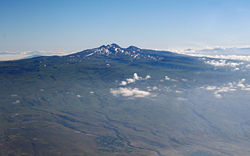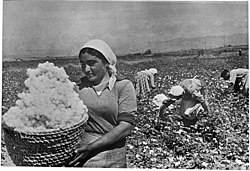Agriculture in Armenia
This article needs to be updated. (November 2010) |



Armenia has 2.1 million hectares of agricultural land, 72% of the country's land area. Most of this, however, is mountain pastures, and cultivable land is 480,000 hectares (452,900 hectares arable land, 27,300 hectares in orchards and vineyards), or 16% of the country's area.[1] In 2006, 46% of the work force was employed in agriculture (up from 26% in 1991), and agriculture contributed 21% of the country's GDP.[1] In 1991 Armenia imported about 65 percent of its food.[2]
Land privatization
[edit]In 1990 Armenia became the first Soviet republic to pass a land privatization law, and from that time Armenian farmland shifted into the private sector at a faster rate than in any other republic.[2] However, the rapidity and disorganization of land reallocation led to disputes and dissatisfaction among the peasants receiving land.[2] Especially problematic were allocation of water rights and distribution of basic materials and equipment.[2] Related enterprises such as food processing and hothouse operations often remained in state hands, reducing the advantages of private landholding.[2]
Swift and decisive privatization quickly eliminated the collective and state farms, which had dominated Armenian agriculture in the Soviet period.[2] Already by 1992 privatization of the state and collective farms had put 63% of cultivated fields, 80% of orchards, and 91% of vineyards in the hands of family farmers.[2] In 2006, family farmers were producing 98% of gross agricultural output, i.e., in 15 years Armenian agriculture transformed completely from the traditional Soviet model of large agricultural enterprises to the market-oriented model of individual or family farms.[citation needed]
The privatization program yielded an immediate 15% increase in gross agricultural output between 1990 and 1991.[2] Agricultural growth continued unabated, and by 2006 gross agricultural output had increased by 75% compared with its level in 1990.[1][3] This growth record has not been matched by any of the CIS countries, putting Armenia in a unique position of stellar agricultural performer in CIS.[3] In 1993 the government ended restrictions on the transfer of private land, a step expected to increase substantially the average size (and hence the efficiency) of private plots.[2] At the end of 1993, an estimated 300,000 small farms (one to five hectares) were operating.[2] In that year, harvests were bountiful despite the high cost of input; only the disastrous state of Armenia's transportation infrastructure prevented relief of food shortages in urban centers.[2]
Agricultural production
[edit]
Armenia produced in 2018:
- 415 thousand tons of potato
- 199 thousand tons of vegetable
- 187 thousand tons of wheat
- 179 thousand tons of grape
- 138 thousand tons of tomato
- 126 thousand tons of watermelon
- 124 thousand tons of barley
- 109 thousand tons of apple
- 104 thousand tons of apricot (12th largest world producer)
- 89 thousand tons of cabbage
- 54 thousand tons of sugar beet
- 52 thousand tons of peach
- 50 thousand tons of cucumber
- 39 thousand tons of onion
In addition to smaller productions of other agricultural products.[4]

Agriculture is carried out mainly in the valleys and mountainsides of Armenia's uneven terrain, with the highest mountain pastures used for livestock grazing.[2] Fertile volcanic soil allows cultivation of wheat and barley as well as pasturage for sheep, goats, and horses.[2] With the help of irrigation, figs, pomegranates, apricots, and olives also are grown in the limited subtropical Aras River valley and in the valleys north of Yerevan, where the richest farmland is found.[2][5] Armenia also produces peaches, walnuts, and quince, and its brandy enjoys a worldwide reputation.[2]
Irrigation is required by most crops, and the building of canals and a system of irrigation was among the first major state projects of the Soviet republic in the 1920s.[2] By the 1960s, arable land had been extended by 20 percent, compared with pre-Soviet times.[2] Most farms had electricity by the early 1960s, and machinery was commonplace.[2] In the Soviet era, women made up most of the agricultural work force; a large percentage of the younger men had responded to the Soviet industrialization campaign by migrating to urban centres.[2] In 1989 farms were operating about 13,400 tractors and 1,900 combines.[2] Unlike other CIS countries, Armenia did not suffer a catastrophic decline in its farm machinery inventory during the privatization, and in 2006 there were 14,600 tractors and 1,700 combines in Armenian farms.[1]
Agricultural production is heavily biased toward crops, which in 2006 accounted for 64% of gross agricultural output.[1] The principal agricultural products are grains (mostly wheat and barley), potatoes, vegetables, grapes (both table and wine), and fruits.[1] In 2006, Armenia produced 212,500 tons of grain, 539,500 tons of potatoes, 915,000 tons of vegetables and melons, 286,000 tons of fruits, and 201,400 tons of grapes.[1] All these numbers (except for grain) constitute significant increases compared with 1989, when Armenia produced 200,000 tons of grain, 266,000 tons of potatoes, 485,000 tons of vegetables, 170,000 tons of fruit, and 119,000 tons of grapes.[2] Livestock production in 2006 reached 66,800 tons of meat (slaughter weight), 620,000 tons of milk, and 464 million eggs.[1] The corresponding livestock production numbers in 1989 were 105,000 tons of meat, 491,000 tons of milk, and 561,000 tons of eggs, i.e., only milk production increased significantly during the post-Soviet period.[2]
References
[edit]- ^ a b c d e f g h Statistical Yearbook 2007, Armenia National Statistical Service, Yerevan
- ^ a b c d e f g h i j k l m n o p q r s t u v Curtis, Glenn E. (1995). Armenia, Azerbaijan, and Georgia : country studies (1st ed.). Washington, D.C.: Federal Research Division. pp. 44–45. ISBN 0-8444-0848-4. OCLC 31709972.
 This article incorporates text from this source, which is in the public domain.
This article incorporates text from this source, which is in the public domain.{{cite book}}: CS1 maint: postscript (link) - ^ a b Z. Lerman, C. Csaki, and G. Feder, Agriculture in Transition: Land Policies and Evolving Farm Structures in Post-Soviet Countries, Lexington Books, Lanham, MD (2004).
- ^ Armenia production in 2018, by FAO
- ^ "Armenia: Apricot exports at record levels in 2013". Archived from the original on 2013-09-27. Retrieved 2013-09-24.
External links
[edit]- Agriculture in the Black Sea Region Archived 2013-09-27 at the Wayback Machine

